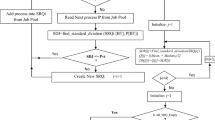Abstract
CPU Scheduling has played a critical role in making efficient systems, It is the mechanism which allows one process to use the CPU for execution while other processes are put on hold because of unavailability of any required resource, with the aim of maximizing the CPU utilization and reducing the waiting time and the turnaround time. This paper presents a new Scheduling Algorithm, which supports preemption, reduces the turnaround time and the waiting time. To show its effectiveness, its comparison is done with other traditional scheduling algorithms including First Come First Serve, Shortest Job First, and Round Robin Scheduling Algorithm, and as a result it was found that the proposed algorithm provides a new and effective scheduling approach which reduces the average waiting time and average turnaround time in a much better way than the traditional approaches.
Access this chapter
Tax calculation will be finalised at checkout
Purchases are for personal use only
Similar content being viewed by others
References
Silberschatz, A., & Gagne, G. Operating system concepts (8th ed.). WILEY.
Mittal, N., Garg, K., & Ashish America (2005). A paper on modified round robin algorithm. IJLTEMAS, 4(X1). ISSN 2278–2540.
Seltzer, M., Chen, P., & Outerhout, J. (1990). Disk scheduling revisited in USENIX. In H. M. Shamim (ed.), Operating system, DCSA-2302.Winter technical conference.
Raman, & Mittal, P. K. (2014). An efficient dynamic round robin CPU scheduling algorithm. IJARCSSE.ISBN: 2277 128X.
Tong, W., & Zhao, J. (2007). Quantum varying deficit round robin scheduling over priority queues. In International Conference on Computational Intelligence and Security (pp. 252–256). China.
Kumar, M. R., & Renuka Rajendra, B. (2014). Prediction of length of the next CPU burst in SJF scheduling algorithm using dual simplex method. In 2nd International Conference on current Trends in Engineering and Technology ICCTET.
Khan, R., & Kakhani, G. (2015). Analysis of priority scheduling algorithm on the basis of fcfs and sjf for similar priority jobs. International Journal of Computer Science and Mobile Computing, 4, 324–331.
Li, J., Ma, T., Tang, M., Shen, W., & Jin, Y. (2017). Improved FIFO scheduling algorithm based on fuzzy clustering in cloud computing. Information, 8(1), 25.
Indusree, J. R., & Prabadevi, B. (2017). Enhanced round robin CPU scheduling with burst time based time quantum. In IOP Conference Series: Materials Science and Engineering (Vol. 263, No. 4, p. 042038). IOP Publishing.
Singh, J., & Gupta, D. (2017). an smarter multi queue job scheduling policy for cloud computing. International Journal of Applied Engineering Research, 12(9), 1929–1934.
Lin, Z., & Huang, H. (2017). Research on weighted rotation fair scheduling algorithm based on hama parallel computing framework. DEStech Transactions on Engineering and Technology Research apop.
Jha, H., Chowdhury, S., & Ramya, G. (2017). Survey on various scheduling algorithms. Imperial Journal of Interdisciplinary Research, 3(5).
Peng, R., & Ding, L. (2017). Research on virtual network load balancing based on OpenFlow. In AIP Conference Proceedings (Vol. 1864, No. 1, p. 020014). AIP Publishing.
Chaturvedi, P., & Sharma, S. (2017). An provision for workflow scheduling using round robin algorithm in cloud. International Journal of Advanced Research in Computer Science, 8(5), 667–673.
Rao, G. S. N., Srinivasu, N., Srinivasu, S. V. N., & Rao, G. R. K. (2015). Dynamic time slice calculation for round robin process scheduling using NOC. International Journal of Electrical and Computer Engineering, 5(6), 1480–1485.
Author information
Authors and Affiliations
Corresponding author
Editor information
Editors and Affiliations
Rights and permissions
Copyright information
© 2019 Springer Nature Singapore Pte Ltd.
About this paper
Cite this paper
Kumar, R. (2019). Cyclic Scheduling Algorithm. In: Shetty, N., Patnaik, L., Nagaraj, H., Hamsavath, P., Nalini, N. (eds) Emerging Research in Computing, Information, Communication and Applications. Advances in Intelligent Systems and Computing, vol 882. Springer, Singapore. https://doi.org/10.1007/978-981-13-5953-8_38
Download citation
DOI: https://doi.org/10.1007/978-981-13-5953-8_38
Published:
Publisher Name: Springer, Singapore
Print ISBN: 978-981-13-5952-1
Online ISBN: 978-981-13-5953-8
eBook Packages: EngineeringEngineering (R0)




